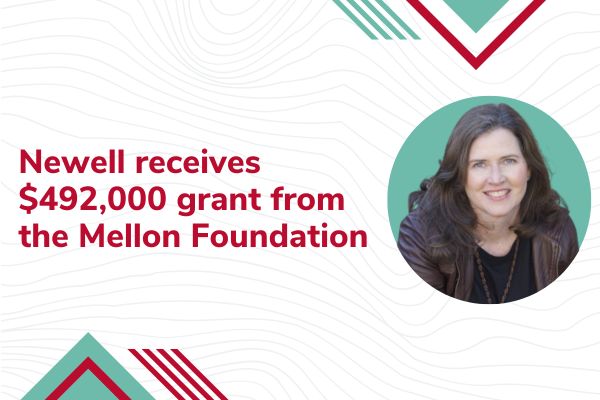Newell receives $492,000 grant from the Mellon Foundation

Margaret Newell, a distinguished professor in The Ohio State University Department of History, was “delighted” to learn she would be receiving $492,000 from the Mellon Foundation.
“Historians generally don’t get these big grants,” she said. “It really was a thrill.”
Newell’s award was part of nearly $3 million in grants from the Mellon Foundation announced last month. Among them was a $1.9 million award to the Department of African American and African Studies.
The remainder supports Newell’s research on the civic engagement and voting rights of African Americans and Native Americans from 1780 to 1920 and a second project offering educational pathways for incarcerated students at the Ohio Reformatory for Women co-led by Mary Thomas, associate professor in the Department of Women’s, Gender and Sexuality Studies, and Tiyi Morris, associate professor in the Department of African American and African Studies.
Newell will use the funds to create a history undergraduate research lab, something common in the sciences but much less so in the humanities.
“Students want lab experience. They want research experience,” Newell said. “The idea of working on collaborative original research at a high level, we grabbed that from the sciences. Historians also do research that is game-changing, so let’s use that concept, too.”
Undergraduate students will work with Newell and three other scholars who received their doctorates from Ohio State – Noël Voltz, John Bickers, and Deondre Smiles – to create biographies of African American and Native American activists who worked to secure or maintain civil rights before the modern Civil Rights movement in the United States.
“Battles for voting rights, battles for other civil rights, battles for Indigenous sovereignty, these are very relevant stories for today,” Newell said. “Many of the issues we talk about from the past, in terms of restrictions to the exercise of citizenship, are still being engaged today.”
This research model presents a special opportunity for students, Newell said. The subjects of the biographies are not well-known – so digging will be necessary.
“You’re a detective,” she said. “You are looking through material to make connections and figure out what was going on, figure out how one event moves on to the next. It’s surprising that some of these changes, these laws, go back to a single person’s petition. We want to teach students and get them excited about the art of historical detection and storytelling.”
After the lab’s first year, Newell hopes to invite students from Historically Black Colleges and Universities and tribal colleges to participate. If the lab is successful, she believes other institutions will follow Ohio State.
“I think the main reason we got the grant is this undergraduate lab,” she said. “I hope it will outlive the project and continue to be part of the history department here, and that other universities will see this model and adopt it.”
The other Mellon grant, of $480,000, will support the Liberation at the Margins Collective (LAM), a group composed of Ohio State faculty, staff and students and incarcerated people at the Ohio Reformatory for Women (ORW).
LAM is part of a larger project led by Thomas and Morris, the Ohio Prison Education Exchange Project (OPEEP), which began in 2019. The project, which is available across Ohio State’s multiple campuses, seeks to expand prison-based education.
Classes are currently taught at ORW, Southeastern Correctional Institution and Richland Correctional Institution. Ohio State faculty and students travel to their assigned prison for classes on-site. Each class is a mix of incarcerated and non-incarcerated individuals.
OPEEP has five areas of focus, said Morris: individual courses, the embedded degree program (which will allow incarcerated people at ORW to earn a degree while in prison), work on Ohio State’s campuses around justice-involved individuals, re-entry after incarceration, and research.
“The LAM Collective fits under the embedded-degree program,” Morris said. “We want to do collaborative research with [incarcerated students]. We want to build and develop their research skills, both so they can support the research that Mary and I are doing, and so they can produce individual research projects.
“We also hope they will then serve as ambassadors and recruiters and build an internal leadership cohort in support of the embedded degree at ORW,” Morris added.
Ohio State is the only Big Ten school that teaches at women’s prisons, Thomas said.
“We’re members of the Big Ten Consortium for Higher Education in Prison. There are more men or people who identify as men in prison, but I don’t believe that number of programs is proportional. It’s a very small number.”
The grant money provides Thomas and Morris the resources they need to treat OPEEP as part of their current jobs, instead of a much-beloved side project.
“[Receiving these funds] is affirming,” Morris said. “You know you’re doing good work.”
“We’ve been doing really lonely work for the last year to build the program,” Thomas added. “Now we’re able to have the affirmation and the time to actually be able to put in the work.”
Demand for OPEEP programming has only grown, both professors agreed. The Mellon funds will allow for further expansion of course offerings.
“There’s a real hunger for a wide variety of courses to be offered,” Thomas said. “Being able to offer some science classes, in addition to humanities, is one of our goals.
“[Incarcerated individuals] don’t get a lot of choice, whether it’s what they’re able to eat or the programming they’re involved in,” she added. “So, having some course choices can be pretty impactful.”
Article written by Franny Lazarus of Ohio State News
